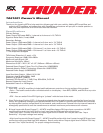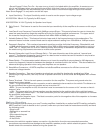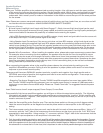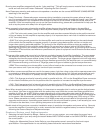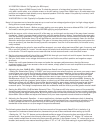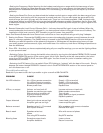X1 POSITION: 100mV–1V (Typically for RCA Input)
• Setting for Factory (OEM) Source Units: To check the amount of voltage that is present from the source
unit, take a multi meter, or a volt/ohm meter, on the AC setting, (range from 100mV up to 10 volts) attach the
positive and negative leads directly to any exposed speaker. It will not matter if the polarity is correct, it will
read the same amount of voltage.
X10 POSITION: 1V–10V (Typically for Speaker Level Input)
Note: It is important not to have the amp set up to receive a low voltage signal and give it a high voltage signal.
Doing this can cause damage to the amp.
2. Adjusting the Gain Control – Before you start setting your amp gains, be sure to defeat all EQs (“off” position).
You want to set the gain levels properly BEFORE applying any equalization.
Start with the source unit’s volume around ¾ of the way up, and the gain on the amp all the way down (counter-
clockwise). Slowly increase the gain clockwise until the speaker starts to distort. Immediately decrease gain
until the distortion goes away. This will be a good reference point on the volume control to where the signal
starts to distort. Remember every CD will be different; use common sense and constantly listen for obvious
distortion and adjust volume accordingly. The gain on the amp has nothing to do with how much power the
amp can produce, just how fast the amp puts out max power. Just like in an automobile, full throttle is very
rarely needed.
Note: When adjusting the gains for two amplifiers strapped, you must adjust each amplifier’s gain, frequency, and
EQ so you will be able to “match” the two amps and ensure both amplifiers are sending the same ac voltage
to the woofer. This will require source materials that include test tones and a volt ohm/multi meter.
a) Set the volume around half, play a flat tone (60-80 Hz) through your head unit and hit repeat. Use this same
frequency and volume for the entire process.
b) Set your multi meter on ac voltage and connect it to the Positive amplifier’s positive and negative output
terminals.
c) Switch the multi meter between the amps and make the necessary adjustments so that the flat tones
produced match. If you have access to two multi meters, simply place one on each amplifier’s terminals and
make the adjustments.
3. Adjusting the Low, 24dB @ 40Hz - 200Hz Variable Low Pass X-over Frequency Controls–
• Setting for Subwoofers: Using “X-OVER” you have control over what frequency you want your amp to start
crossing over your signal. By turning this control all the way counter-clockwise you are crossing the signal
over at 40Hz (the range is counter-clockwise 40Hz to clockwise 200Hz). This means that the amp will send
the woofers frequencies from 20Hz to 40Hz and then start to taper down as the frequencies go over 40Hz
(24dB/octave roll off). The industry standard for low pass crossover point is right around 90Hz. However, by
experimenting with the crossover point (higher or lower) you will find what sounds best in this install. The
decibel per octave roll off (dB/oct) means how fast the amplifier tapers down as the frequencies get higher.
This amp uses a 24-decibel per octave roll off, which is pretty steep, or tapers off fairly quickly from the
crossover point. This design complements both the subwoofer and the mids to provide greater musical detail.
4. Setting the 20Hz–50Hz, 12dB Variable Subsonic Filter – This feature will help remove some of the potentially
damaging low frequencies from your subwoofer system. By turning this control all the way counter-clockwise
you are limiting the signal below 20Hz. By turning this control all the way clockwise you are limiting the signal
below 50Hz. Start at 20Hz and adjust this feature until your bass response sounds smooth and detailed.
5. Adjusting the Parametric Equalizer – In some applications, the bass amplifier needs some help in boosting
or cutting certain frequencies. A parametric equalizer is distinguished from a conventional equalizer circuit
in that it allows the user to control the level of the boost or cut as well as the center frequency and the
bandwidth of the boost or cut (the range of frequencies affected).
The following steps describe what each of the three controls of the parametric Bass EQ do in isolation. It is
important to understand these behaviors, because they must all be considered when setting up the EQ.
• Setting the “Q”: The “Q” feature can be adjusted to affect a range of frequencies from as wide as 0.5 to as
narrow as 4.0. As a general rule of thumb, start tuning with a “Q” setting below “2”. Higher “Q” values are
rarely needed unless there is some truly bizarre acoustic problem in the system. Lower “Q” values give you a
broader (and usually more natural-sounding) effect. A “Q” of “1.6” (10 o’clock setting) is a good starting point.



